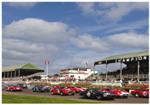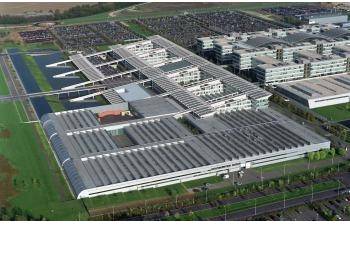|
| ||||||
|
Renault Technocentre Celebrates Tenth Anniversary
18th June, 2008 | |||||
|
This year marks the tenth anniversary of the Renault Technocentre. This large-scale technological and architectural project was developed to provide Renault with benchmark status in automotive design and development. It offers its 11,500 resident employees cutting-edge resources for carrying out their projects effectively in an ultra-modern, environmentally-friendly atmosphere. In all, more than 20 vehicles have been developed there since its implementation. At the Technocentre, vehicle development is undertaken in a comprehensive manner and production methods are designed along with the vehicles themselves. Digital technology makes it possible to conduct ten or so projects simultaneously. The Technocentre is a key contributor to the growth and international development of the Renault Group, a goal whose importance has intensified with the implementation of Renault Commitment 2009. Average saving of approximately €150 million on each new vehicle developed After undergoing a period of reorganisation in both its structure and work methods, Renault decided to bring all of its geographically dispersed Research and Development units (engineers, management and technical staff) together in a single site - the Technocentre. Its 11,500 staff members work on every phase of a project, from preliminary studies through to the latest prototype ready for assembly on the production line. Their wide-ranging goals include placing innovation at the heart of design and development, making constant strides in quality, cutting costs and lead times and promoting the globalisation of Renault Group models. Today, manufacturers are renewing and updating their model ranges to anticipate the increasingly demanding requirements of customers. Renault released eight passenger cars between 1945 and 1965, 17 from 1965 to 1985, 14 in the 1985-1997 period and 14 between 1997 and 2005. In the context of Renault Commitment 2009, 26 new vehicles will be launched in the 2006-2009 period. This ever-accelerating tempo of range renewal means that development lead times must be even shorter and the proximity of the various Technocentre units to each other contributes significantly to making this possible. Cross-functional project management also enables rapid decision-making. Production ramp-up lead times have also been cut – by two-thirds since the founding of the Technocentre. This achievement and its continued improvement, are largely dependent on the quality of the work performed in the design and development phase and the close contact of the various units assigned to product and process engineering. Similarly, in the domain of powertrains (engines and gearboxes) – an equally important area with the same concerns regarding coherence – the development resources available have all undergone reorganisation on their long-established sites (Rueil in particular). Their goals are the same as for the Technocentre, especially in relation to development costs and lead times, with a 30% reduction as their set objective. Thanks to the Technocentre, Renault has benefited from an average saving of €150 million in development costs for each new vehicle.
A community of men and women Currently, 11,500 people work daily at the Technocentre site, including some 2,000 contractual service providers.
The Technocentre is also a unique place for work placement and training: more than 1,000 people (temporary staff, interns, apprentices, etc.) work at the site each year. It is also an important centre for internal training in design and production methods and standards for the Renault Group. The management of the Guyancourt and Rueil Lardy Sites, devised in April 2007, is responsible for improving both general and work conditions on site. Product/process development With the development of the Technocentre, vehicles can now be designed in a comprehensive way, starting with preliminary studies, right through to the final prototype. In fact, from the very outset, when the many elements that make up a car have just begun to be crafted, their production mode is also established in cooperation with the plants. Today, this 'product/process' way of working is coupled with another imperative: planning, from the earliest moments of a vehicle's development, of after-sales and logistics concerns (in particular the ability of its parts to be stored and transported) as well as early preparation of elements of problem diagnosis and repair. In addition, the Technocentre has an on-site 'mini-plant', the Centre de Réalisation des Prototypes Véhicules (CRPV, Prototype Vehicle Production Centre). This entity fulfils a dual mission: it manufactures the prototypes necessary for the development of future vehicles and it ensures geometric quality while simultaneously validating the production process for new models. The technical solutions chosen for car production and assembly are also tested there. Experts from the various other buildings also support projects from the 'upstream' phases to the 'downstream' ones: material studies, quality appraisals, anticipation of manufacturing conditions and factory supply logistics. 'Rational' architecture In its buildings, the Technocentre reproduces the different phases of a vehicle's design and development. In the first building, the Advance Precinct, the initial drafts of future models are drawn up. Customer studies, an analysis of general social trends and choices regarding innovations and design lead to the establishment of the general technical and styling features of the future vehicle.
In the Technocentre's second building, ‘The Hive’, engineers and technical staff from Renault's engineering departments form a ‘project team’ that designs and develops the vehicle section by section. Each team is in charge of the development of a single vehicle. Intrinsically multi-disciplinary, project teams are comprised of engineers from a variety of specialty areas as well as purchasing, quality and industrial process planning managers. In 2003, a new building, known as ‘The Gradient’, was built to house 2,000 people from the Production and Logistics Department. Thanks to their new-found proximity to the product-process engineers and the purchasing and quality departments, its production experts are now better able to boost the performance and competitiveness of Renault's production sites throughout the world (38 production sites and seven logistical centres in 17 countries in 2008) and to do so in a consistent manner. Digital simulation, a development tool Today, 90% of all design and development operations are performed using digital simulation. The Technocentre is equipped with 5,000 computer-aided engineering (CAE) workstations and three full-scale computer image displays. Several test benches and simulators also make it possible to verify lighting, roadholding, ergonomics and to perform virtual driving tests well before a vehicle has actually been built. The Technocentre also possesses twelve supercomputers able to perform complex digital simulations in just a few hours and a unique simulator known as Ultimate. This highly dynamic performance driving simulator is the very first of its kind in the industrial sector. Thanks to its mobile platform mounted on six cylinders, it is capable of making both longitudinal and lateral movements over an area of seven metres. It accurately reproduces phenomena such as acceleration, braking and roll, making it possible to speed up adjustments to vehicle ride and handling.
Environmental concerns are essential The Technocentre was built on a 150-hectare site in Guyancourt, approximately 20 kms west of Paris. The site is located in a semi-urban zone and the closest residential housing can be found just outside the Technocentre's boundaries. The site is fully integrated into the surrounding landscape and great care is taken in the management of its natural heritage and the conservation of the neighbouring forests and environment. The site was awarded ISO 14001 certification in 2000. Thanks to the Technocentre's environmental team and its network of over 100 individuals present throughout the site's various departments, resident staff are kept up-to-date on environmental issues. The Technocentre recycles rainwater, which is collected on waterproof surfaces and used to water the site's vegetation and to replenish its bodies of water. This operation represented a saving of 19,400m3 of water in 2007. Between 2005 and 2007, water consumption was significantly reduced (10%) and the consumption of sanitary drinking water proportionate to the number of resident staff fell 37% over a six-year period. The Technocentre has set a waste recycling objective. The goal is to achieve a material recovery rate of 65% by the end of 2008. To do this, over 70 different types of waste are collected separately. At end 2007, 64% of the total waste volume generated on the site was recycled and 97% of it was recovered (material + energy). 10 years of Technocentre events Renault regularly takes advantage of the Technocentre's hospitality capacities to organise internal and external communications operations on the site. These have included: Renault's centenary celebrations in 1998, the Formula One launch event in 2002 to mark Renault's return to F1 racing and the Logan Press launch that was held on 2nd June, 2004. To celebrate the Technocentre's tenth anniversary, Renault is organising a number of festive events throughout the year for Technocentre employees as well as their colleagues from nearby sites including Rueil-Lardy, Boulogne-Billancourt headquarters, the Equinove site in Plessis-Robinson (Hauts-de-Seine) and the Flins plant (Yvelines). An open day is planned for later in 2008. Timeline: 1989: decision to equip Renault with a major technology centre
| ||||||
ABN 47106248033 |
 |
All rights reserved. |
 The
"Classic Motor Sport Tour" includes visits to Goodwood Revival,
Donington Grand Prix Collection, Grand Prix Historique de la Vienne, Manoir de L'Automobile and Museum de L'Automobile at Le Mans and, for a
farewell dinner, Atelier Renault on Champs Elysees. Also included are city tours of London and Paris, Classic Team Lotus Works tour and Brands
Hatch race master (with an opportunity of a drive in a high performance Renault). This great tour includes return economy air fares, departure
tax, transfers, 13 breakfasts, 3 dinners and 13 nights accommodation.
The
"Classic Motor Sport Tour" includes visits to Goodwood Revival,
Donington Grand Prix Collection, Grand Prix Historique de la Vienne, Manoir de L'Automobile and Museum de L'Automobile at Le Mans and, for a
farewell dinner, Atelier Renault on Champs Elysees. Also included are city tours of London and Paris, Classic Team Lotus Works tour and Brands
Hatch race master (with an opportunity of a drive in a high performance Renault). This great tour includes return economy air fares, departure
tax, transfers, 13 breakfasts, 3 dinners and 13 nights accommodation.
